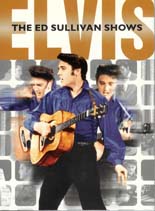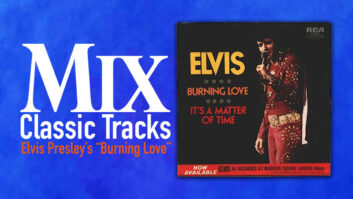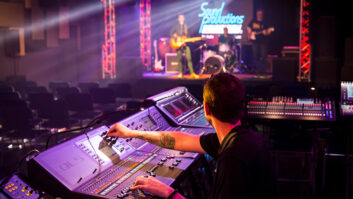
For my generation of American baby boomers, The Beatles’ first appearances on The Ed Sullivan Show in the winter of 1964 were watershed events that seemed to change the very fabric of American youth culture, almost overnight. But just eight years earlier, on The Ed Sullivan Showhad a similarly profound effect on American teens when it hosted a series of three appearances by the original king of rock ’n’ roll, Elvis Presley.
For the record, Elvis’s first national TV appearances were on the Dorsey Brothers’ little-watched Stage Show, The Milton Berle Show and The Steve Allen Show. Sullivan was initially reticent to book Elvis, but the buzz—and large viewing audience—for the Allen show convinced Ed to book the up-and-coming sensation.
This remarkable set of three DVDs presents all three of those 1956-57 Sullivan shows in their entirety. At the time, they drew the largest audiences of any TV program ever, and the ripples of those shows were felt throughout America for years in ways both seen and unseen. In short, these shows are important.
Now, one could be cynical about this release and say, why not just release Elvis’ performances and few bonus features on a single CD? Why include the full hour of all three programs? Context, my friends! Part of what makes Elvis on the Sullivan show so fascinating is that he seems like this barely tame-able rebel—all smirks and pent-up energy ready to explode at any moment—in the midst of a plethora of acts who could not be more mainstream. The Ed Sullivan Show was really styled after a traditional vaudeville revue—it was singers and comedians and magicians and acrobats; a “variety” show in the best sense. And America loved it. Ed and his producer scoured the world for the greatest talents they could find, and every Sunday night a huge viewing audience tuned in to watch. There hasn’t been an equivalent show for many, many years, and by that I mean a variety show had true cross-generational appeal. For better or worse, the ’60s “generation gap” put that concept to rest. Our parents didn’t want to see the Rolling Stones (though they’d tolerate a song or two on Ed Sullivan, amidst the jugglers and the adorable Italian puppet mouse Topo Gigio), and after a while teens didn’t want to see Metropolitan Opera star Robert Merrill or tumblers from Hungary.
But back in ’56, the grown-ups had no idea what was about to be unleashed on the world. And the opening quarter-hour of the first program, from September 9, 1956, offers no clues. The first surprise it that Sullivan is nowhere to be seen—he was still recovering from a serious automobile accident several weeks earlier, and the great British thespian Charles Laughton (you loved him in the definitive version of The Hunchback of Notre Dame) handles the hosting duties. Playing off his image as an erudite Englishman, he opens the show reading poetry, of all things! Well, actually, it’s jokey poetry—one is about the theory of relativity (Einstein being all the rage in the new atomic era), another is a limerick that manages to rhyme “Debussy” with “fussy.” There’s a sign of the times—the audience evidently knew who Debussy was, and laughed heartily! (Alas, that would not happen today.) From that opening, it’s on to a parade of odd acts I’d never heard of: The Brothers Amin is a two-man acrobatic team that completely blew my mind—they’d no doubt be revered members of a Cirque Du Soleil troupe today, wearing hipper outfits and working to bombastic synth music, instead of performing to the strains of The Ed Sullivan Show orchestra. Broadway star Dorothy Sarnoff sings “Something Wonderful” and a song from The King and I. Then it’s the first of several endless live commercials for Mercury automobiles. One forgets how incredibly dull commercials used to be, as an onstage announcer drones on endlessly about “roadability” and “more torque per pound.” The first time we see the audience is when they applaud the commercial—you’d be hard pressed to find a straighter-looking crowd, with all the men and boys in ties and the women decked out in nice dresses and more hideous horn-rimmed glasses than you can imagine. The Vagabonds are a comedy-music quartet—precursors to The Smothers Brothers, I’d venture to say—and they slay the audience with a humorous take on “Up the Lazy River,” in which the stand-up bassist isn’t able to contain his jazz leanings and “ruins” the song.
And then it’s on to Elvis. Standing in front of four framed Gold records, Charles Laughton explains that each of them represent one million records sold. Then he tells us that Elvis is in Hollywood working on his first movie, so the action switches to a stage there. From our perspective 50 years after the fact, it’s hard to imagine just what the effect of untold millions of people seeing Elvis for the first time must’ve been. But there he is: almost impossibly handsome, in a relatively conservative sport coat, his slick black hair shaped into a pompadour that towers over his forehead; the deep-set eyes, full lips that alternately part to reveal a glistening smile or quiver slightly and part, somehow both defiant and inviting. (Jeez, I’m not trying to sound like a porn novel here, but the man had serious sex appeal!) He sings “Don’t Be Cruel,” which was a month into its 18-week stay at the top of the charts, and you can tell that he’s diggin’ every second of it. He manages to seem both humble and confident. He tones down the swagger a bit, but you can see it on his face anyway. His four-man vocal backup group, the Jordanaires, are decked out in plaid sports coats, their short hair quite a contrast to Elvis’s gleaming pomp. The sound is crisp, the mix surprisingly true, though on this song we don’t see his trio; we just hear them. The girls in the audience scream at the slightest provocation—a twitch of Elvis’ shoulders, a smile, a wink. The camera, famously, focuses on Elvis from the waist up, and he’s clearly on his best behavior for Mr. Sullivan. For song number two, Elvis introduces a brand-new song—the title track from the film he’s working on, “Love Me Tender.” (He didn’t tell the crowd he dies at the end of that one!) Within a few weeks of this program, it, too, would be a smash hit.
Okay, that’s enough of that, kids! The 72 million people who were watching the show (a third of the country!) next had to endure tap dancers Conn & Mack hoofing it to “Tea for Two” (squaresville, man!), another live car commercial, Laughton reading from James Thurber….Meanwhile out in the vast audience, the kids are probably squirming: “Gotta have more Elvis! Where’s Elvis?” No, not yet. Here’s Indian chanteuse Amru Sani, in dress sari, singing “I’m in the Mood for Love,” comedian/magician Carl Ballantine, Toby the Dog (a cute Jack Russell terrier) using a potty and answering the phone, another Mercury (The Big M!) commercial, and then…yes, finally!…back to Hollywood, and cripes, Elvis really tears it up this time, singing Little Richard’s “Ready Teddy” and throwin’ it down as Scotty Moore lays into some nice electric gee-tar, Bill Black thumps the bass and D.J. Fontana cracks his small drum set. There are some amazing long shots across the band showing all of Elvis (oh, lawdy!) in action, and all of a sudden it becomes crystal clear why adults were so afraid of him: hips shakin’, limbs flailin’, he looks like he’s going to burst out of the screen! Finally, the show wraps up with a dollop of “Hound Dog” (the flip of “Don’t Be Cruel,” believe it or not, but a hit in its own right), and the fun is positively infectious. I’ll bet this was said in thousands of households across America around 9 o’clock that night: “Hey mom, I don’t wanna go to school tomorrow. I wanna listen to rock ’n’ roll!” “Now, now, sweetie. You march right to bed, while your father and I have a martini and watch What’s My Line?”
The other two shows are only slightly less magical. Ed is back for those, and he takes every opportunity to mention what a fine young man Elvis is, as if to reassure parents everywhere that this is no juvenile delinquent out to corrupt the nation’s youth. At the beginning of show number two (October 28, 1956), he once again sings “Don’t Be Cruel” and “Love Me Tender” (neither is quite as powerful as the previous show’s versions). In a second segment he sings “Love Me” (which immediately shot up to Number 2 within a couple of weeks), and then in the show’s closing moments he reprises a bit of “Hound Dog” again, and Sullivan informs us that Elvis will be back in a few weeks. (Vaudeville highlight from Show 2: Spanish ventriloquist Señor Wences… “s’awright!”). For the third show (January 6, 1957), Elvis is decked out in a garish puffy-shirt and sparkly vest (foreshadowing his Vegas period many years later?), but this time the camera really does only shoot him from the waist up (lock up your children!). He starts the first of his three segments with a medley—a verse each from “Hound Dog,” “Love Me Tender” and “Heartbreak Hotel,” followed by a full “Don’t Be Cruel.” Elvis is as relaxed as can be, erupting into little laugh hiccups occasionally and definitely playing to the girls to get them to scream. There’s something charming and yet still innocent about it: He knows he has the power, but he’s only using it for good. The middle segment (following another fabulous ventriloquist, an Ed Sullivan impersonator and the network debut of a young comedienne named Carol Burnett) offers “Too Much” (which is formulaic Elvis; it still hit Number One) and then a nice change of pace: the ballad “When My Blue Moon Turns to Gold Again.” (Can you say “dreamy”?). But it’s his final appearance on that show (after dancers, a clown act, a Latin-pop singer and even a minute with middleweight boxer Sugar Ray Robinson) that’s the coolest: “Peace in the Valley,” which taps into that wonderful country gospel space that Elvis hit occasionally. Good stuff!
All in all it’s a fascinating slice of ’50s Americana. Video quality is top-notch throughout and the audio surprisingly good—which brings us to the semi-obligatory Mix magazine-esque portion of our program. Recently, I chatted with restoration engineer Brain San Marco of Chace Productions (of Burbank, Calif.) to learn a little more about what goes into bringing old mono audio tracks like these in to the DVD age.
One interesting aspect of The Ed Sullivan Show during this era is that you almost never see a microphone. In fact, boom mics were used almost exclusively to capture the acts on stage. However, if you look closely during “Ready Teddy” on Disc One, you’ll also see a mic sitting next to Scotty Moore’s tiny amp. But most of what we hear is clearly from the boom mic(s), which makes the clarity and definition quite remarkable.
San Marco’s work began by importing the audio track from an already synched DBC (digital beta-cam) video master into his workstation at Chace. The Sullivan Show audio tracks had their share of minor problems: “The main one is you get a lot of camera noise depending on which direction they’re facing, and you get different hums depending on where the boom is sitting. A lot of what I had to did to those tracks was hum removal and also fixing some distortion, which is typical of this old stuff because [the original audio track] is so limited in its bandwidth it was easy to peak-out, so you get a lot of that peak distortion, which fortunately is pretty easy to fix in today’s world. I also had to deal with some lighting hums and the AC running. It’s all stuff you wouldn’t really notice unless you listened really closely,” which of course is what restoration engineers are paid to do.
San Marco adds that “Cube-Tec’s software bundle has really cool restoration tools. It’s mostly used in music mastering. But it’s got really good notch filtering to get in there and take out specific [noises]. It has real-time de-cracklers and de-poppers and de-clickers, and also interpolation tools that allow us to manually remove pops and ticks. One of the coolest things they have is called the SpectraPolator, which allows me to go in pull things out within both time and frequency, so I don’t necessarily have to affect the whole program. You can see it all on a color graph. So if there’s, say, a thump below 30 Hz that’s not involved with anything going on [in the music], I can go in and choose that little spot and take it out, which is an incredible tool that wasn’t around two years ago. I work in WaveLab and Nuendo; those are the applications I use that my Cube-Tec plug-ins are associated with.”
Any thoughts on the overall quality of the audio on these shows? Any special challenges? “They sounded pretty good for the most part,” San Marco says. “They didn’t require anything out of the ordinary. But I’m floored every day [by] how back then, with the lack of technology, they seemed to be able to accomplish so much just by thinking about what they were doing and wondering, ‘How can we get around these issues?’ Versus today, where they say, ‘Oh, we’ll deal with it in post!’ It comes to me, and I’m like, ‘Huh? What’s going on here?’” he laughs.
Finally, there are also some nice bonus features on the Elvis/Sullivan discs, including interviews with various Friends of Elvis, some great previously unseen silent home movie footage of primal, pre-hit Elvis two years earlier at an outdoor concert in the South, and also film of Elvis and his wife riding horses. And for those who have no interest in wading through all the other acts (which you should check out at least once…c’mon, be adventurous!) there is an Elvis-only playback option, too.



![A stroll through Abbey Road. Watch out for that bus! Photo: Phil Castellano. [Editor's Note: Steve is last in line.]](https://www.mixonline.com/wp-content/uploads/2025/06/2025-06-26-Blog_Fig1-MAIN-353x199.jpg)



